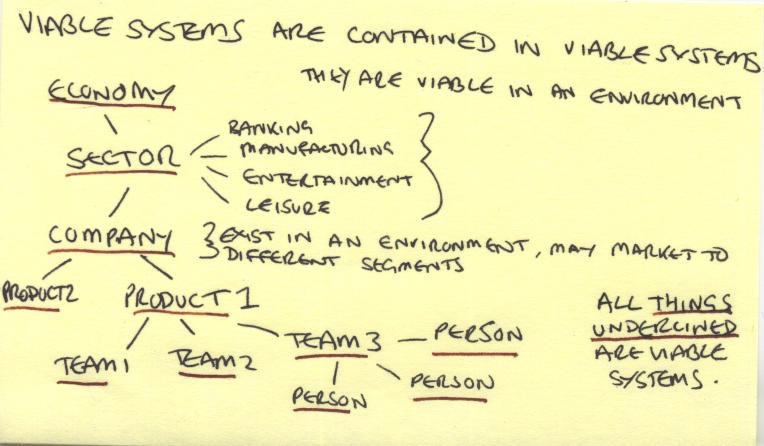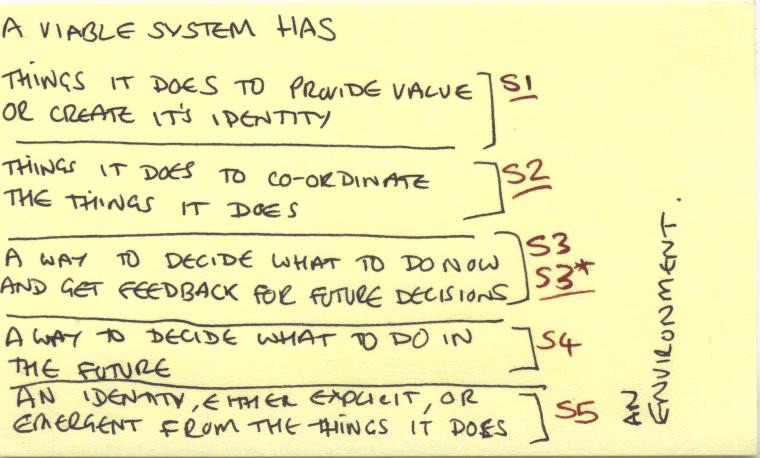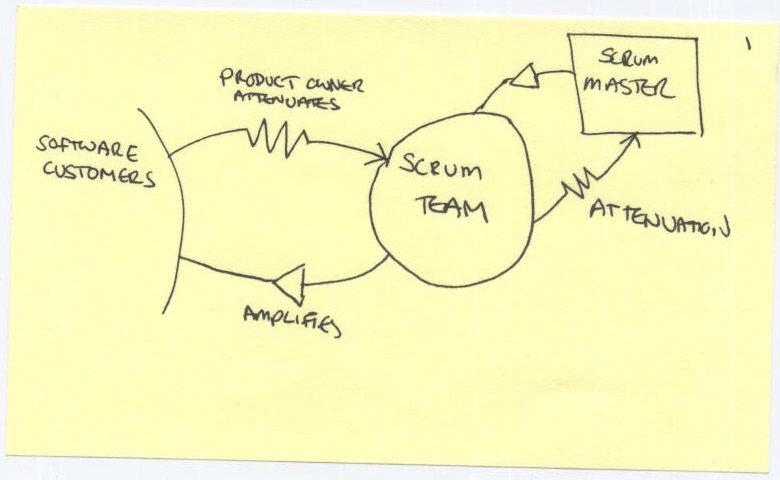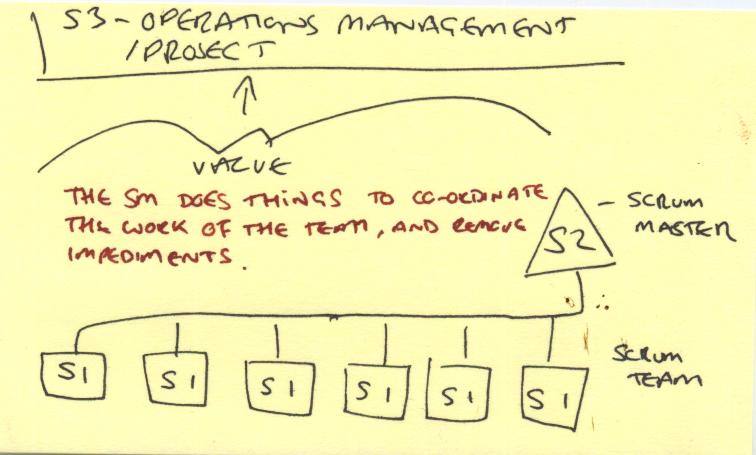
The innovation should be right about here.
The world is changing fast, and some of the organisations doing the changing have insights that the rest don’t. Visualisation of information allows people to point at a model outside of their head, ask better questions and make better decisions. Wardley Maps are a great way to visualise what happens to provide value to someone in a way that makes for better questioning about why. This post is about the kind of questions that we may like to ask to create the change.
I’m releasing v1 of this post. If you spot any typos or missing words let me know in the comments please.
What is mapping?
I’m using Simon Wardley’s “Wardley Maps”. We show at how a user need is met through a value chain on the y-axis. We use the x axis to show how we source the components in the value chain, from the left to right.
An example map from Simon Wardley is below. There are two Users, and the need A also requires other elements. From this map we can see that we choose to build the things in Red, we buy or rent the things in blue, and the things in green are commodities.

CC 3,0 Share Alike
Sourcing the components ranges from
- inventing your own
- building something unique
- buying a product or service
- renting a service or commodity
Over time the way we meet user needs moves to the right. In the map below the way to build a website has moved through these domains. For simplicity, I’ve not added elements further down the chain, and the y-axis is far less important than the x-axis here.
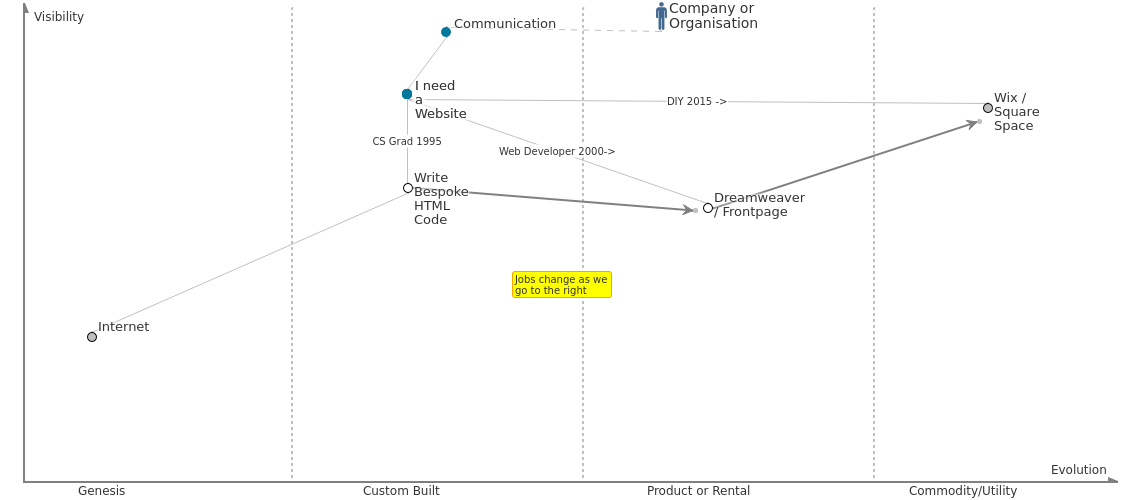
If you need more information about Wardley Maps, this post explaining the Wardley Mapping Canvas by @benmosior is a great intro
Once you can see where you are sourcing all of the parts of the value chain from you can ask “Does it still make sense to build or buy the thing here?”. In the above example, you may have employed a Computer Science graduate in the 90’s to write HTML code, until you could buy a product to do that for you, and pay less to employ a Web Designer. Those who wrote code by hand claimed to write faster and better sites, but eventually, they needed to get jobs elsewhere. Similarly, in 2018 people with Web Development Package Skills are replaced by DIY efforts currently on Square Space or Wix.
This movement over time is a central part of Wardley Maps.
User Needs
Over time the above map follows Gartner’s hype cycle. New things get invented, they need some work to build products that people are happy using, and then if they cross the chasm more industrialised efficient products and services emerge.
The products and services meet a user need that is used to anchor the map.
Everything that is successful, that once made sense to build yourself, becomes a product. While there are various strategic to stop things being taken and improved by others, successful companies will need to alter the things they build in-house if they want to compete with companies that arrive later. In this case, Amazon disrupted its book business with e-readers, and Costa Coffee produce drinks from an automated machine in many petrol stations, with little of the Costa experience.

I’m needy.
Wardley maps anchor on User Needs. These differ depending on the persona. For example, for a children’s party you can source a totally different value chain depending on the type of party you want and can pay for. In this Map you can see the high-level requirements for cake, entertainment and location. You can source the items for your party from anywhere, but you’re unlikely to have a unique party with a cake from Sainsbury’s, or at an established children’s party venue.
There is a market for everything in the map, and the provisions move to the right. For example, you could invent and build your own one-off children’s party Escape Room. If it’s a potentially profitable idea then there will be some artisan companies making them commercially. Then bigger entertainment companies may start to make brand name cookie-cutter offerings. These will be cheaper, and meet a need, but not the same need as the artisan ones. If your need is ‘A party like no other’ you’ve moved on.

There is the ability to make money providing service at each part of the x-axis, however, over time those things that are successful will move to the right as they are produced more efficiently and become products for general consumption. Then, they have a slow entropic death 🙂
Disruption
As companies develop their product they find ways to build thing more efficiently. Incumbent suppliers, who have not needed to look for efficiencies are prone to be disrupted by “Digital” companies who are able to take the element of the value chain and move them to the right (or remove the requirement altogether) using innovative IT, Cloud Computing and Lean Thinking. Canonical examples of disruption are Kodak, Retail and Blockbuster, but Banking and Education are also targets. Anywhere where the reason for sourcing part of the value chain is “we’ve always done it like that” is potentially disruptable.
Previously successful companies are currently trying “Digital Transformations” to try to keep competitive with new companies that do not have their legacy. The new companies will be disrupted eventually. Lots of consultants are trying (and largely failing) to digitally transform companies. Interestingly many use tools that are also moving right on the Wardley map, (roll out the transformation, yeah?) and this is key is understanding the failure. More in a future post…
I didn’t know I liked that bit!
It’s worth mentioning that the new way of meeting a User Need will be different from the old. There may be things that customers appreciate that they may not realise at the time of disruption.
- Books deivered to the door – But I liked browsing bookshops
- 10000s of digital pictures – But I liked sitting as a family looking at old photos
- Packages delived by drone – But Posties also keep an eye out for vulnerable people living alone
- Educated online by a MOOC – But I liked moving away to University and creating deep lifelong friendships, and going out every night.
- Good coffee available everywhere – But I like an artisan coffee shop experience
- I like books – I’m not even buying a kindle….
So there is life after industrialisation for certain artisan pursuits. You can still buy axes to chop wood and hipsters will press your coffee through an Aeropress by hand.
User needs are also created – feeding our impulsive monkey brain, our need to belong to a tribe or to feel good about ourselves etc. Most strategic play, however, is based on cost. But it doesn’t need to be. Also creating the user needs is part of Strategy not on the map, people don’t just want a new thing for no reason.
How not to be disrupted
There are techniques to not be disrupted. These include patenting your ideas, creating a strong brand and talking down your competition. Linux is cancer by Steve Balmer was an attempt to stop Linux moving operating systems to the right and commoditising them. Many other methods to stop operating systems being commoditised had been tried by Microsoft and failed.
Sometimes, providing an experience by doing some things way more inefficiently than they need to be done provides the user with what they (now) need – Bespoke Apple Stores, for example, make the Apple experience harder to disrupt.
Another example is retooling your factories with people instead of robots so you can sell bespoke customisations to your customers that your competitors cannot offer. Your competitors are too industrialised with robots to compete. See my post about Mercedes proposing to replace robots with people. They are keeping their product in the profitable centre of the map.
Know your place
What part of the x-axis are you good at? There are different approaches, skills, mindsets, vocabularies and metaphors in use at each part of the x-axis from building something unique to managing a rental product or commodity.

These guys focus on doing one thing well
The team above are amazing at making whatever it is you’re doing super efficient. Even the one getting a different perspective is not seeing things very differently.
On the other hand, this bunch below is totally going to reinvent how you do everything. It may not be be pretty or efficient, but it’s going to be different.

Reinventing the world. Photo via Popular meme.
If your company and staff are great at industrialisation and six sigma improvements you need to be looking for opportunities to disrupt incumbent companies who have created a market where small improvements can be profitable due to volume. Nations sell themselves as great places for this sort of work.
Maybe your company takes good ideas that are just catching on and drives the move to a product with a great user experience and support. This is a different set of competencies.
New products and ideas must also come from somewhere. Big companies are not the place for having brand new ideas.
How to have a good idea
Wardley Maps show the climatic pattern of value moving right and becoming industrialised. But how do things appear on the left? Cynefin gives us a clue. We can potentially create ideas by removing constraints to move slightly into the chaos domain, and benefit from potentially different ways of doing things. A constraint you can remove is the need to immediately be profitable. Ideas from the Garage or Basement by a part-time entrepreneur fit here .
At research-based Universities, time and facilities for Academics to experiment in a safe to fail environment helps with new ideas. Cynefin requires at least one of the experiments to be naive. This happens when a chemist applies their heuristics to a physics problem. Cross disciple research groups provide this opportunity.
Universities have a whole raft of ways they exchange value with the environment. One of them is as an ideas factory. (I find the factory metaphor hilarious, so bad it’s good.)
This can be shown equally well with a Wardley Map or with Cynefin Dynamics. They show different perspectives and have different perspectives. Below is a Wardley Map with the needs of Academics to publish papers, and the needs of an external organisation whose conpetencies include marketing and manufacturing innovative products.

The need for immediate profit is one of the constraints that is removed to take advantage of ideas from chaos. New developments are either written up and published as papers, meeting the Academics need to produce visible output. If suitable the ideas may be patented before publishing. If the patent has an obvious application then companies requiring an innovative edge may licence the technology. The University spends the proceeds on more research and bureaucracy.
If the idea can’t be licensed, a Spin Out company may be created to develop a product up until the company can be sold. A University has no interest in developing and marketing a product, and the improvements in production required to meet pricing and all the other things required. They sell the company and get back to the area of the Wardley Map they are good at.
Putting it all together
This bog only shows only one pattern on the map. For more patterns and strategies see Simon Wardley’s book on medium.
Wardley Maps are a great visualisation that work well looking at how we add value personally with our skills, with the products our employer sells, and how our sector of industry is performing.
They form part of a set of visualisations looking at the entire value chain from what people do, all the way up. The world is getting disrupted at an astonishing rate, and mapping helps us to see what the future may hold.
Using maps we can discuss the sourcing of parts of the value chain, the approaches from agile to six sigma that may be used to deliver those parts. The culture of the organisation that are likely to excel in these domains can also be discussed. Finally, strategic patterns can be overlaid on the maps to discuss how to act in the future.
There are ideas in this post from Wardley Mapping, Cynefin, VSM, and loads of other approaches. Cynefin is a trademark of Cognitive Edge.















